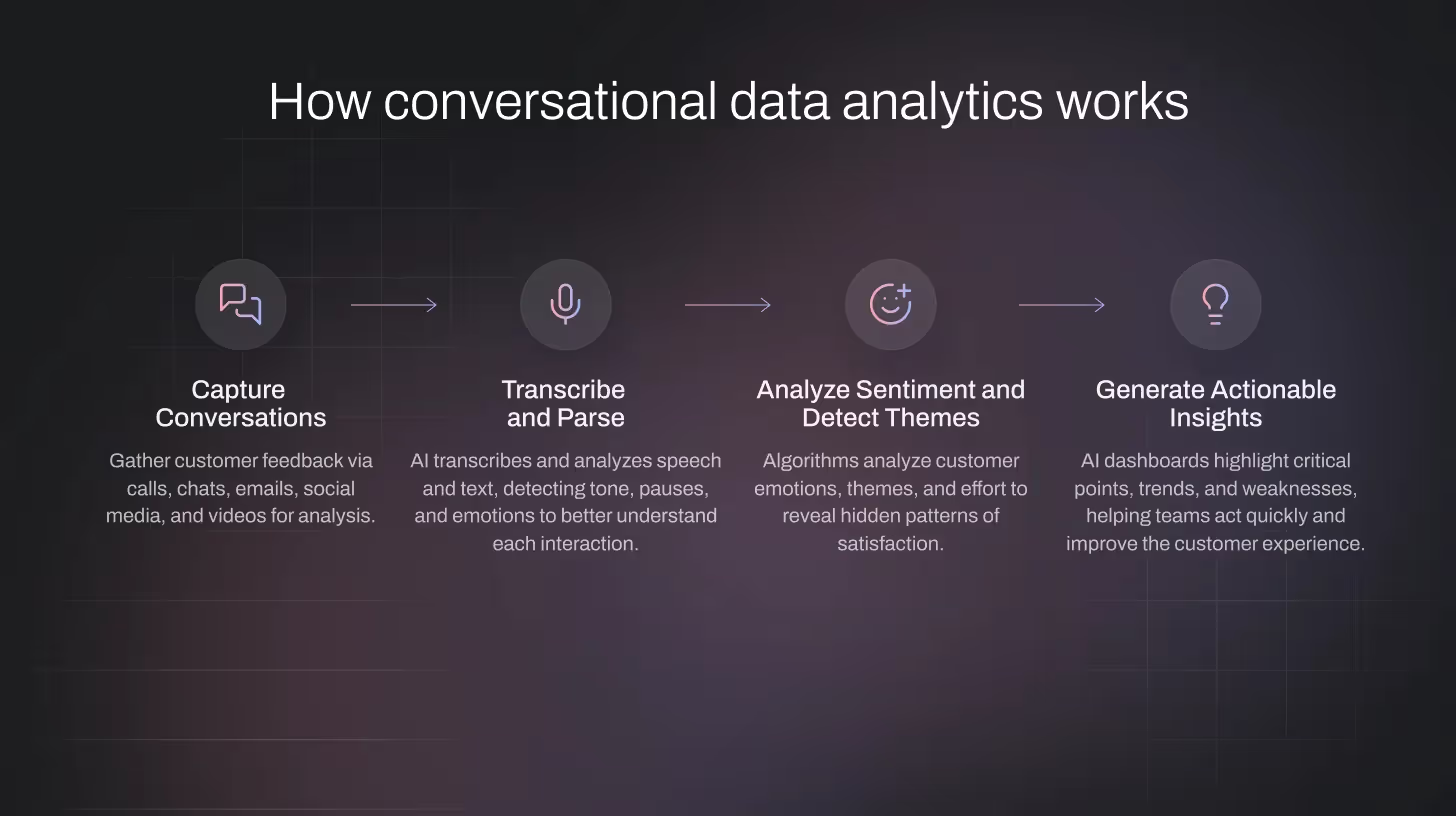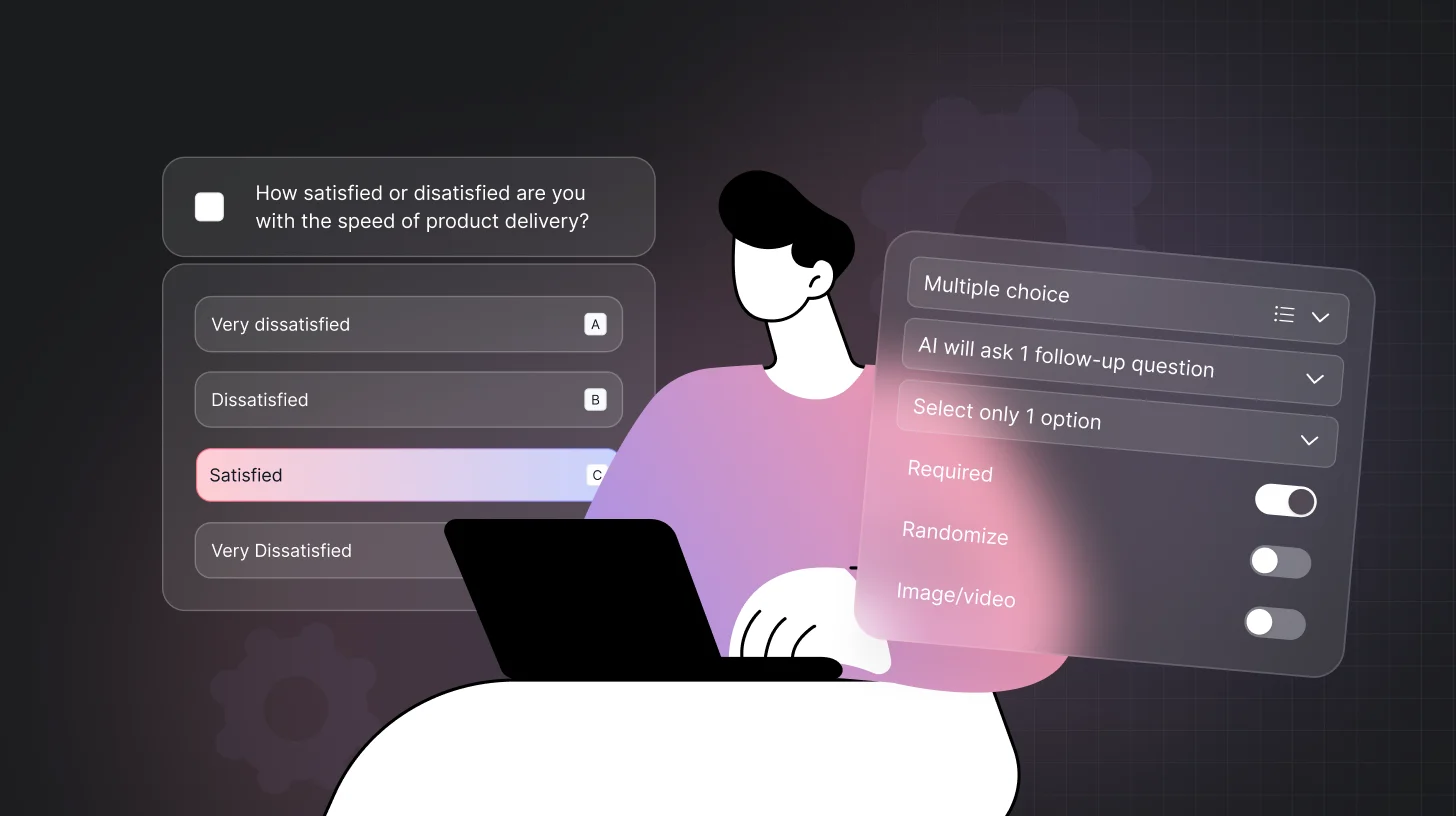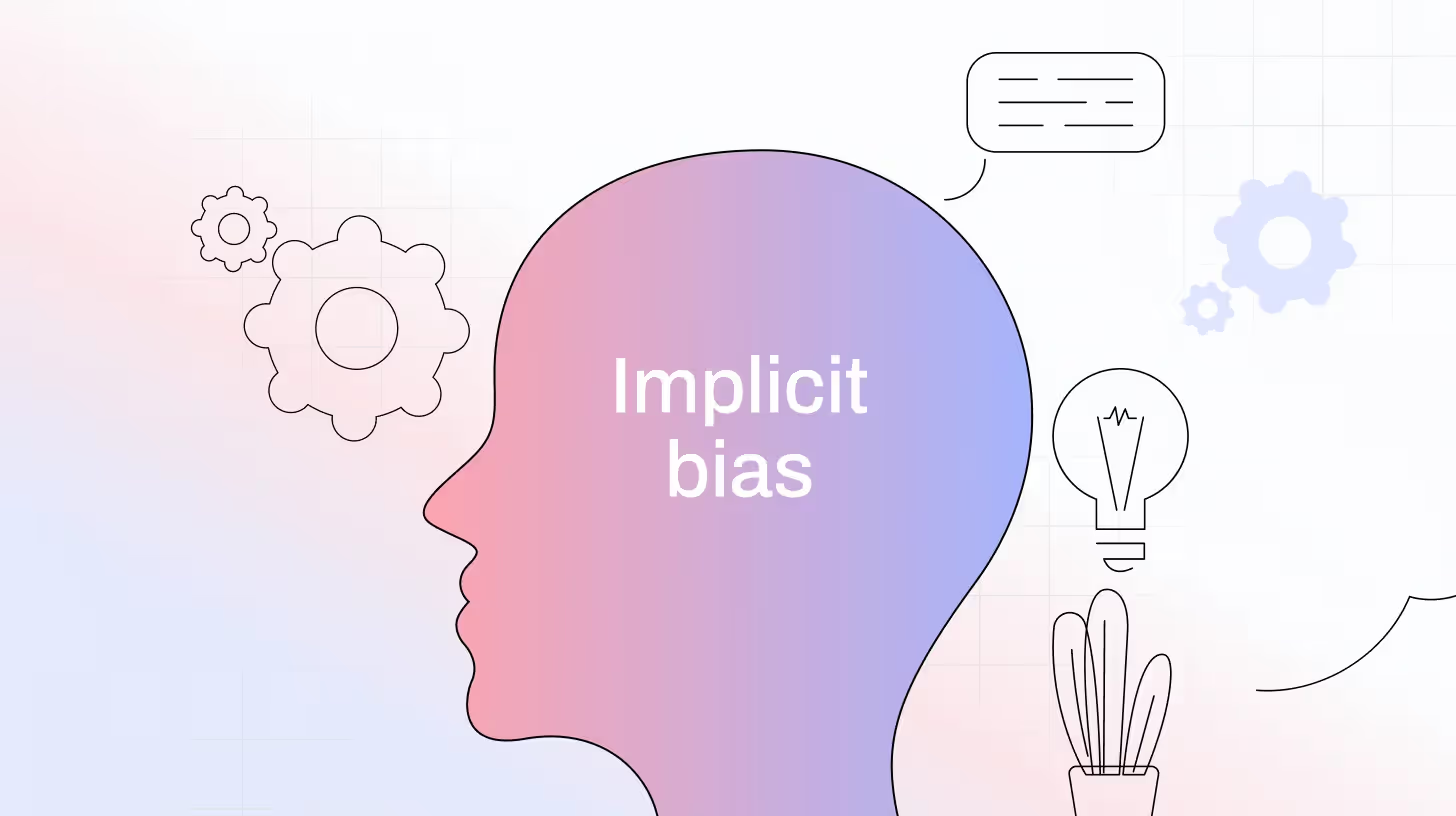How Conversational Analytics Works and Improves Business Decisions

For decades, data has been the currency of business strategy. But in today’s economy, where customer expectations shift by the minute, traditional dashboards can’t keep up. Spreadsheets and quarterly reports tell you what happened, but not why. That missing “why” lives in the conversations your teams have every day: sales calls, support chats, feedback emails, social threads.
This is where conversational analytics is changing the game.
Instead of treating these interactions as noise, businesses are finally starting to treat them as rich, real-time data streams of customer intent, emotion, and opportunity. Powered by AI and natural language processing, conversational analytics turns everyday dialogue into insights showing you what your customers truly think, feel, and need before they even fill out a survey.
What is Conversational Analytics?
At its core, conversational analytics is about turning everyday customer interactions into insight gold. It listens to every side of the story, what your customers say, think, and feel, and how your teams respond. And it’s not limited to a single channel. Every touchpoint matters, phone calls, live chats, social media threads, surveys, and even video meetings all contribute valuable context.
What makes it special is its ability to go beyond surface-level data. With conversational analytics, you can see why a customer sounds frustrated, how an agent handles objections, and where the conversation shifts from problem to solution.
Why Every Business Needs Conversational Analytics
Let’s be honest, traditional feedback tools only tell you part of the story. They capture what customers choose to share, not what they actually feel in the moment. Customer Conversational analytics fills that gap; it listens in real-time, pulling insights straight from the conversations that already happen every day.
Capture the Complete Customer Story
Static Surveys? Helpful, sure. But they’re limited structured questions can’t always catch the real emotion behind a customer’s words. Conversational analytics, on the other hand, taps into that raw, unfiltered truth.
It listens to what customers say, how they say it, and even what they don’t say. It’s the difference between “our customers are satisfied” and “our customers are frustrated but too polite to say it.”
For example, a healthcare provider uncovered a hidden pain point through conversational analytics. While traditional surveys suggested that patients were satisfied, deeper analysis of real conversations revealed a different story, growing frustration over complicated appointment scheduling. The solution was simple but powerful: streamline the booking process. The result? Happier patients, smoother experiences, and stronger retention.
Reduce Customer Effort and Improve Experience
Every analyzed conversation is a chance to make the customer journey smoother without asking for another survey response. By listening to natural interactions, businesses can spot friction points before customers even complain.
The less effort customers have to put in, the more likely they are to stay. Conversational experience analytics helps you see exactly where that effort hides (confusing policies, slow replies, repetitive hand-offs) and helps you remove them.
Identify Trends Before They Escalate
Here’s where conversational analytics shines brightest: spotting trouble early. By analyzing chat, call, and social interactions in real time, it can flag emerging patterns before they snowball into public issues.
For example, A gaming company noticed a subtle spike in player frustration during live chat sessions about performance lag after a new update. Because the analytics caught it early, the team patched the issue quickly, stopping a wave of negative reviews before it hit Reddit and gaming forums.
Key Metrics to Track in Conversational Analytics
Tracking the right metrics in conversational analytics isn’t just about numbers; it’s about understanding the story behind every customer interaction. These insights help teams measure not just performance, but empathy, efficiency, and customer impact.
Here are some of the most meaningful metrics to keep an eye on:
Sentiment Score: Tracks customer emotions in real-time to detect shifts in mood or engagement.
Customer Effort Score (CES): Measures how easy it is for customers to resolve issues, helping identify friction points.
Net Promoter Score (NPS): Evaluates customer loyalty by asking how likely they are to recommend a product or service.
First Response & Resolution Time: Measures speed and efficiency in support interactions, which directly affects satisfaction and retention.

Understanding the Types of Customer Data
Not all customer data is created equal, and that’s important to remember. When brands think about feedback, they often jump straight to surveys. CSATs, NPS, and CES are all useful, but they only capture what you ask for. That’s solicited feedback structured, measured, and predictable.
But there’s another world of insight you’re probably missing: the unsolicited, unstructured kind the data customers give you without being asked. It’s found in every conversation, every complaint, every emoji dropped in a chat. That’s the raw, emotional truth of the customer experience.
To make sense of it, let’s break down the main data types businesses collect:
- Operational Data (O-Data): The “what happened” — transactions, performance metrics, service logs.
- Behavioral Data (B-Data): The “how it happened” — how customers interact across channels.
- Experiential Data (X-Data): The “why it happened” — the emotions, opinions, and sentiment behind actions.
Each of these can be structured (numbers, scores) or unstructured (words, emotions), and either solicited or unsolicited. Conversational analytics thrives in the unstructured and unsolicited space where real human truth lives.
How Conversational Analytics Works
Conversational analytics works by combining artificial intelligence (AI), natural language processing (NLP), and machine learning to turn everyday customer interactions into powerful business insights. Instead of relying on traditional surveys alone, this technology analyzes what customers actually say across different communication channels.
Step 1: Capture Conversations
The process begins by collecting customer interactions from multiple sources phone calls, live chats, emails, social media posts, and even recorded video interviews. This ensures that every piece of customer feedback, whether solicited or unsolicited, is captured for analysis.
Step 2: Transcribe and Parse
Next, AI-powered transcription tools convert spoken or written language into structured text. Using speech recognition and language parsing, the system identifies subtle cues like tone, hesitation, and emotion, offering a richer understanding of each interaction.
Step 3: Analyze Sentiment and Detect Themes
Advanced sentiment analysis algorithms then assess emotional tone, detect recurring themes, and measure the customer’s effort or frustration levels. This helps uncover patterns behind satisfaction or dissatisfaction insights that traditional feedback methods often miss.
Step 4: Generate Actionable Insights
Once data is processed, AI customer insights dashboards highlight pain points, emerging trends, and service gaps. These insights empower teams to take immediate action, improving customer experience and reducing churn.

Read: The Ultimate Guide to Sentiment Analysis: What It Is & Why It Matters
Conversational Analytics Case Studies
British Airways — Call-Analytics Reveals Hidden Customer Issues
A major transformation for British Airways involved extracting real insight from what customers actually say. The airline analysed approximately 35,000 calls (about 10% of their general-enquiry call volume) through a conversational-AI platform from Sabio Group.
- What they discovered: “Seven out of our top ten contact reasons were completely different from what we had anticipated.”
- Why that matters: When you listen to real customer voice rather than relying only on assumptions or structured survey questions, you find blind spots.
- The takeaway: Using conversational analytics enabled them to reshape service operations based on the true why behind customer calls.
You can read more here.
Gong / Proposify — Sales Conversations Re-Engineered for Accuracy & Growth
In a B2B sales context, analysing what sales teams say (and what prospects say in response) can shift outcomes dramatically. For example:
- Proposify used conversation-intelligence tools from Gong to analyse call transcripts and detect coaching opportunities. The result: forecast accuracy improved by 41%.
- Sales managers reported that the time spent diagnosing performance issues dropped by 32% because the system surfaced insights automatically.
- Why this fits conversational analytics: It analyzes unstructured conversational data (sales calls) to generate structured, actionable business insights. Source
How UserTesting Accelerated Growth with AI Feedback Intelligence
Industry: User Experience Research
Challenge: The UserTesting mid-market team was under pressure to drive expansion and retention at scale. With rapid customer growth came a data overload of conversations, feedback, and interactions scattered across platforms.
Their existing tools only offered surface-level survey data and delayed insights. As a result, the team struggled to:
- Identify churn and expansion signals in real time
- Understand why customers felt the way they did
- Scale personalized engagement across hundreds of accounts
In short, they had data but no direction.
Solution: UserTesting adopted TheySaid’s AI Feedback Intelligence platform to unify and analyze every customer signal from emails and chats to calls and AI interviews in one real-time system.
TheySaid’s conversational analytics automatically decoded tone, emotion, and intent across interactions, surfacing insights that traditional survey dashboards missed.
With AI-driven sentiment and predictive feedback analysis, the team could now:
- Detect early signs of churn risk or dissatisfaction
- Spot buying intent and upsell opportunities faster
- Automate customer summaries and account insights for Sales and CS teams
Instead of relying on quarterly survey cycles, UserTesting gained a live pulse on customer health updated daily.
Results:
- 22% increase in Net Revenue Retention (NRR) within 12 months
- 38% faster detection of churn risk signals, leading to proactive renewals
- 3x increase in actionable insights captured from customer interactions
- 45% reduction in manual analysis time, freeing teams for strategic initiatives
- Higher engagement, with 92% of customers participating in AI-driven feedback loops

Best Practices in Conversational Analytics: Turning Conversations into Competitive Advantage
If you’re investing in conversational analytics, you’re not just collecting data; you’re unlocking a real-time pulse of your business. The key lies in how you use it. Below are proven best practices that top-performing brands follow to turn everyday conversations into deep, actionable insights.
Think Omnichannel Because Customers Don’t Stick to One Path
Customers jump between channels like never before: a DM today, a call tomorrow, maybe a chatbot in between. The best conversational analytics platforms don’t just analyze one stream of dialogue; they connect every touchpoint.
When your system captures conversations across phone calls, emails, chatbots, and social media, you get the full story, not fragmented sound bites. It’s the difference between reading a sentence and understanding the whole paragraph of customer intent.
Pro tip: Choose a conversational analytics or AI feedback platform such as TheySaid that integrates seamlessly with your CRM and customer experience tools.
Turn Conversations into Resolutions with Real-Time AI Guidance
It’s not enough to know what customers are saying; what matters is how well your team responds. The best tools don’t just look back at performance metrics; they guide live conversations in the moment.
AI-powered assistants can prompt agents with helpful cues recommending empathy phrases, surfacing knowledge-base articles, or flagging rising customer frustration before it spirals. The goal isn’t to replace humans, it’s to enhance human decisions in real time.
Measure What Matters and Act on It
Data without direction is noise. Start by tracking KPIs that directly reflect experience quality, such as:
- Average Handle Time (AHT) – How efficiently are your agents resolving issues?
- First Contact Resolution (FCR) – Are you solving problems the first time customers reach out?
- Customer Satisfaction Score (CSAT) – How do customers feel about the outcome?
But don’t stop at tracking. The magic happens when you correlate these numbers with insights from conversations about what words customers use, how tone changes, and where frustration builds. That’s where true business intelligence lives.
Real-World Use Cases of Conversational Analytics
Let’s explore how businesses are using conversational analytics to improve products, anticipate behavior, and elevate service quality.
Improving Products and Services
Customers won’t always fill out surveys, but they will tell your agents what’s not working if you’re listening. By analyzing unstructured feedback across calls, chats, and reviews, brands can detect product weaknesses and opportunities for innovation.
A SaaS company discovered that 42% of “feature request” calls stemmed from confusion about an existing capability, not a missing one. By improving onboarding content, they reduced support volume by 18% in three months.
Conversational analytics unites scattered opinions into patterns you can act on faster than traditional feedback loops ever could.
Understanding Customer Motivations
A customer might say they “can’t log in,” but what they really mean is “I’m frustrated because I can’t pay my bill before the deadline.” Conversational analytics digs beneath the surface to decode emotional drivers.
While traditional CRM systems capture what happened, conversational intelligence uncovers why it happened. That’s how you shift from reactive service to predictive strategy, identifying potential churn triggers or upsell moments before they’re visible in your dashboard.
Predicting Future Behavior
Every conversation leaves a trail of behavioral breadcrumbs. When analyzed over time, these patterns can predict future buying intent, satisfaction, or churn risk.
Imagine catching a brewing issue before it trends on social media.
A consumer electronics brand spotted a recurring frustration with battery life in live chats weeks before negative reviews appeared online, giving them time to adjust their messaging and release a patch proactively.
This is how conversational analytics transforms real-time data into foresight, letting businesses make smarter, faster, and more human decisions.
Elevating Customer Service
Training customer service teams is no longer about guesswork. By analyzing thousands of interactions, conversational analytics highlights which phrases, tones, or approaches lead to positive outcomes.
Say your agents often struggle with de-escalating tense calls. By studying these moments, AI can identify common triggers and recommend calmer, more empathetic phrasing.
The result? Happier customers, more confident agents, and measurable improvements in customer satisfaction and loyalty.
TheySaid: Powering the Future of Conversational Analytics
If you’ve ever wished for a single place to capture every customer signal, voice, text, emotion, or even silence, that’s exactly what TheySaid is built for.
This isn’t just another analytics dashboard. It’s the everything feedback app where conversational analytics, AI interviews, voice-based insights, and sentiment intelligence work together to uncover what your customers are really saying (and not saying).
TheySaid listens across every channel, calls, chats, social threads, support tickets, and even AI-led interviews using tech AI and turns all that noise into clarity. Instead of juggling five different tools for surveys, analytics, and summaries, TheySaid gives you one unified feedback ecosystem powered by AI.
Behind the scenes, here’s what drives its intelligence:
- Conversational AI that understands human language and emotion in real time.
- Sentiment and intent analysis that detects mood, urgency, and what truly matters to your customers.
- Machine learning models that uncover trends and hidden behavioral patterns before you even ask.
- Automated summaries and action items that translate insight into execution instantly.
In a world where every brand is trying to listen louder, TheySaid helps you understand deeper. It’s how modern companies close feedback loops faster, predict customer needs sooner, and build relationships that actually last.
Ready to turn conversations into growth? Book a demo
Key Takeaways
In today’s experience-driven economy, conversational analytics has become the strategic differentiator for businesses that truly listen. By transforming unstructured data from calls, chats, and interviews into strategic intelligence, it enables leaders to understand sentiment, intent, and emerging risks in real time. Platforms like TheySaid go beyond traditional surveys, combining AI interviews, emotion analysis, and automated actions to give organizations a live pulse of their customer base. The outcome isn’t just better insights; it’s a smarter, faster, and more human way to drive growth, loyalty, and innovation.
FAQs
What are the main benefits of conversational analytics?
Key benefits include improved customer experience, early detection of churn risk, better agent performance, more accurate forecasting, and a deeper understanding of customer needs.
What industries use conversational analytics?
It’s used across industries, including SaaS, e-commerce, banking, healthcare, travel, and customer support, anywhere customer conversations happen at scale.
How is conversational analytics different from sentiment analysis?
Sentiment analysis focuses only on emotional tone, while conversational analytics goes further, analyzing intent, context, and behavioral patterns to deliver actionable insights.






.webp)








.svg)